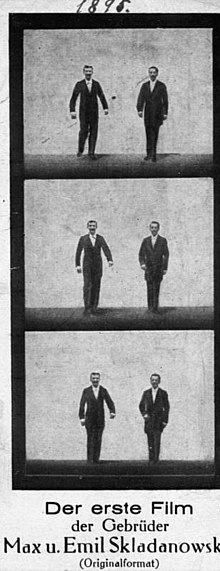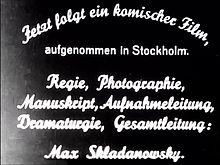Max Skladanowsky
Max Skladanowsky (born April 30, 1863 in Pankow near Berlin , † November 30, 1939 in Berlin) was a pioneer of film. With his brother Emil Skladanowsky (1866–1945) he developed the bioscope , with which they projected short film sequences in front of a paying audience for the first time on November 1, 1895. With this pioneering achievement, Skladanowsky went down in film history .
Life


Max Richard Skladanowsky was the fourth child of Carl Theodor Skladanowsky (1830-1897) and Luise Auguste Ernestine Skladanowsky. After school he began his training as a photographer and glass painter in 1877 in the Werner photographic studio at Alten Schönhauser Strasse 24 and with the glass painter and lithographer Dehn at Schönhauser Allee 48 in the Prenzlauer Tor district , today Pankow district .
In 1879 he found a job in Willy Hagedorn's theater apparatus factory, where he was responsible for “fog pictures” and fog machines. In the same year, the father Carl, together with his two sons Max and Emil, founded a company for the production of mechanically moving fog images. Max Skladanowsky showed this together with his father on tours through Germany and Europe. The first demonstration took place on November 18, 1879 in Friedrichstrasse 218 in the Great Hall of the Berlin Flora . After his father withdrew from the joint company, the brothers Max and Emil continued to run it and developed new attractions for their performances, including an electric-mechanical-pyrotechnic water theater. In February 1893 they made a guest appearance at the Orpheum in Frankfurt am Main .
Dissatisfied with the quality of the painted fog pictures , Skladanowsky experimented with photographic image sequences. In 1894 he first built a first film camera (crank case I) , later a projection apparatus ( bioscope ) .
For a fee of 2500 Reichsmarks, he presented his first films from November 1, 1895 in the Wintergarten vaudeville , which were shown as the final number in a vaudeville program. The demonstration of the bioscope was announced in advertisements as "the most interesting invention of modern times". The 15-minute film program, consisting of eight short film strips, which also included The Boxing Kangaroo , was well received by the audience and received attention from the press. An editor of the Staatsbürger-Zeitung wrote on November 5, 1895:
“The finale of the performance jumps over to the smaller stage of the Bioscop. The ingenious technician uses delightful momentary photography and brings it to an enlarged view, but not rigid, but lively. The devil should know how he does it. "
For four weeks Max Skladanowsky showed his short films every day in the winter garden, always in front of a sold out house with around 1500 guests each. The brothers then traveled through Europe and made guest appearances in Copenhagen and Stockholm , among others . In Djurgården in Stockholm they filmed Comical Encounters in Stockholm Zoo (1896), which is regarded as the first short film with a plot to be recorded in Sweden. They soon supplemented their program with Berlin street scenes, followed later by the first short films with storylines such as Der Nachtliche Freier (1896) and Not Alone (1896).
On December 28, 1895, Skladanowsky took part in the demonstration of the technically superior cinématograph by the Lumière brothers in the Grand Café and then improved his “Bioscop” projector. But he lacked the necessary capital to establish himself on the market and perhaps also the commercial business acumen, which is why he had to get out of the moving images business about 1½ years after his winter garden commitment.
After he was born in 1896 a. a. After the arrival of a railway train , the last demonstration of the bioscope in Stettin followed in 1897 and the two brothers separated. From then on Emil moved on with the changing decorations and the water theater. From then on, Max Skladanowsky devoted himself more and more to the sale of flip books ( pocket cinematograph , living pictures in book form , see flip book ) and three-dimensional pictures (plastic world views) .
In the following years, the two brothers got into a dispute regarding the authorship of the Bioscop , which the Berlin Chamber of Copyright Law only decided in 1930 in favor of Max Skladanowsky.
Skladanowsky's grave, which is cared for as an honorary grave of the city of Berlin , is located in the Pankower Friedhof IV, Berlin-Niederschönhausen , Buchholzer Straße (Herthaplatz), main entrance, left behind. An official plaque of honor of the city of Berlin can be found on his long-standing house at Waldowstraße 28 in Niederschönhausen. Not far from there, Wrangelstrasse was renamed Skladanowskystrasse in 1951.
In 1995 the German director Wim Wenders shot a homage to The Skladanowsky Brothers (film title) together with students from the University of Television and Film Munich . Among other things, it mentions why Skladanowsky's inventions were technically inferior to the ideas of the French Lumière brothers and could therefore not prevail. Lucie Hürtgen-Skladanowsky, the daughter of Max Skladanowsky, born in 1904, has a say. Parts of the film were recorded with a classic silent film camera.
In September 2010 Skladanowsky was honored with a star on the Boulevard der Stars in Berlin .
The original bioscope is now in the Potsdam Film Museum , where it came from the Bitterfeld District Museum . There is a replica of Skladanowsky's camera.
Movies
- Exit after the alarm (1896)
- The guard comes to the rifle (1896)
- The Guard Moves Up (1896)
- A jolly company in front of Tivoli in Stockholm (1896)
- Strange Encounter in Stockholm Zoo (1896)
Exhibitions
- 2014: Pankow as a motif. Max Skladanowsky - film pioneer and photographer. , Museum Pankow , Berlin .
literature
- Michael Althen: A fair child. "The Winter Garden Program" 1895 by the Skladanowsky brothers . In: Peter Buchka (Ed.): German moments. A sequence of images on a typology of the film (series: “Off-Texts”, 1, of the Munich Film Museum). Belleville, Munich 1996, ISBN 3-923646-49-6 ; P. 8f. (on p. 9: image from "Winter garden program"); first: Süddeutsche Zeitung , 1995
- Joachim Castan: Max Skladanowsky or the beginning of German film history . Füsslin, Stuttgart 1995, ISBN 3-9803451-3-0
- Joachim Castan: Skladanowsky, Max Richard. In: New German Biography (NDB). Volume 24, Duncker & Humblot, Berlin 2010, ISBN 978-3-428-11205-0 , p. 486 f. ( Digitized version ).
- A life with the cinema . In: Berliner Zeitung , July 6, 1994
Web links
- Literature by and about Max Skladanowsky in the catalog of the German National Library
- Newspaper article about Max Skladanowsky in the press kit of the 20th century of the ZBW - Leibniz Information Center for Economics .
- Max Skladanowsky in the Internet Movie Database (English)
- Max Skladanowsky at filmportal.de
- Max Skladanowsky estate with biography and film directory in the introduction in the Federal Archives (holdings N 1435)
- Max Skladanowsky - glass painter, inventor, film pioneer . Federal Archives
- “What Wagner was to music, I am to film!” The film pioneer Max Skladanowsky was born 150 years ago . Deutschlandfunk , April 30, 2013
Individual evidence
- ^ Announcement on the exhibition , accessed on September 7, 2014.
| personal data | |
|---|---|
| SURNAME | Skladanowsky, Max |
| BRIEF DESCRIPTION | German film pioneer |
| DATE OF BIRTH | April 30, 1863 |
| PLACE OF BIRTH | Berlin |
| DATE OF DEATH | November 30, 1939 |
| Place of death | Berlin |



